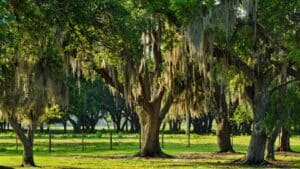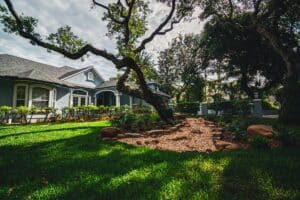
Tree-Centric Strategies for Sustainable Landscape Design
Planting a Greener Future
Imagine a torrential downpour. Not on barren land, but on a landscape thriving with trees. Rainwater cascades through leafy canopies, slowing its descent, soaking into thirsty roots, and replenishing the earth. These silent heroes, our trees, are not just rain guardians, water wizards, and erosion warriors; they are the cornerstone of sustainable landscape design.
Rooted in Sustainability:
Tree roots delve deep, weaving a natural web that anchors the soil and prevents erosion. This not only protects land from washing away but also safeguards precious topsoil, the lifeblood of healthy ecosystems. By reducing the need for artificial land stabilization methods, trees minimize resource consumption and promote natural resilience.

Like living sponges, trees absorb vast amounts of rainwater, reducing surface runoff and preventing floods. They act as gentle filters, purifying water as it seeps through their roots and the surrounding ecosystem. This replenishes groundwater reserves, providing a sustainable source of clean water for communities and ecosystems alike.
Climate Champions:
Tree canopies create shade, cooling urban environments and reducing reliance on energy-intensive air conditioning. Their leaves absorb carbon dioxide, a key greenhouse gas, mitigating the effects of climate change and promoting a healthier planet.
Beyond the Forest Fringe:
The benefits of trees extend beyond lush forests. In urban landscapes, they create vibrant green havens, reducing air pollution, providing noise buffers, and offering natural play spaces. Strategically placed trees in agricultural landscapes provide windbreaks, regulate soil moisture, and attract beneficial pollinators, all promoting sustainable farming practices.
Investing in the Future, One Tree at a Time:
Embracing trees as an integral part of sustainable landscape design is not just about environmental benefits; it’s about creating a future where communities thrive in harmony with nature. By planting and nurturing trees, we invest in cleaner air and water, healthier ecosystems, and vibrant communities. Let’s build a world where every landscape sings with the whisper of leaves and the promise of a sustainable future.
Remember:
- A single mature tree can absorb hundreds of gallons of water per day.
- Trees in urban areas can reduce stormwater runoff by 40-60%.
- Planting trees along shorelines and riverbanks protects against erosion and flooding.
- Investing in trees is investing in a sustainable future for all.
Strategies for Tree-Centric Landscape Design
Site Assessment and Tree Selection:
- Microclimatic analysis: Prioritize planting trees to shade buildings and streets, reducing energy consumption and urban heat island effect.
- Native and climate-adapted species: Choose trees suited to local soil and climate conditions, requiring minimal watering and promoting biodiversity.
- Right tree, right place: Consider mature size, root systems, and light needs when placing trees to avoid future conflicts with infrastructure or neighboring plants.
Designing for Water Management:
- Rain gardens and bioswales: Incorporate strategically placed trees (e.g., willows, maples) in low-lying areas to capture and filter rainwater, reducing runoff and replenishing groundwater.
- Living green roofs and walls: Utilize trees and shrubs on rooftops and walls to insulate buildings, filter air pollution, and manage stormwater runoff.
- Permeable paving: Design pathways and patios with tree-compatible materials like gravel or pavers to allow water infiltration and support root growth.
Enhancing Biodiversity and Ecosystem Services:
- Multi-layered plantings: Create diverse ecosystems by combining trees with shrubs, perennials, and groundcovers to attract pollinators, beneficial insects, and birds.
- Habitat corridors: Plant trees to connect fragmented green spaces and provide wildlife with safe passage,promoting ecological balance.
- Food forests: Design landscapes that integrate fruit and nut trees with edible shrubs and herbs, creating productive and sustainable food sources.
Community Engagement and Education:
- Partner with local nurseries and conservation organizations: Collaborate to source native trees, educate clients about the benefits of trees, and promote local tree planting initiatives.
- Interactive landscape designs: Create spaces that encourage people to connect with nature, such as treehouses, educational signage, and community gardens.
- Advocate for tree-friendly policies: Support policies that protect existing trees, promote urban forestry, and incentivize sustainable landscaping practices.
By incorporating these proactive strategies, landscape design professionals can elevate their role beyond aesthetics and embrace trees as powerful allies in building resilient, sustainable, and vibrant communities.
Remember, every tree planted is a step towards a greener, healthier future for generations to come. Let’s work together to ensure our landscapes flourish with the silent might of trees!
